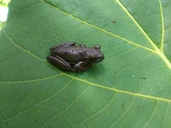|
Description
Previously confused with Ptychohyla leonhardschultzei (Campbell and Smith 1992; Duellman 1970) which is found on the Pacific Slopes of Guerrero and Oaxaca, not the Atlantic like P. zophodes. The following information comes from Campbell and Duellman (2000). Members of this species are brown/brownish-gray dorsally in life, copper colored iris with fine black reticulations. A tarsal fold is also present. The following characters are based on a male holotype: head as wide as body, but slightly longer than wide. Head width 33% SVL, snout rounded with vertical keel on rostrum when viewed dorsally but truncate when viewed in lateral profile. Lips are moderately thick and slightly flared. Supratympanic fold well developed, extending from eye across top of tympanum, whose upper edge it covers, down to the insertion point of the arm. Diameter approximately 50% diameter of eye, but separated from the posterior margin of the eye by 1.1 times the diameter of the tympanum. Ventrolateral edge of forearm firnged with distinctly raised dermal ridge which has tubercles. Cloaca is directed posteriorly at upper level of thighs. The region below cloacal opening is coarse in texture. Skin on throat, chest, belly, and proximal four fifths of ventral surfaces of thighs are areolate. Dorsal patterns are variable (relative to those of holotype) in that some posess less markings on the dorsum and in some the blotches are very small. There is also variation in the venter of some frogs, in which there is a lot of dark pigment arranged in many discrete spots rather than mottling. Tadpoles. Fifty-nine tadpoles of many stages were collected on April 1983, the following information comes from tadpoles in Gosner (1960) stages 25-41: maximum total length of tadpoles is 22.2 (Stage 25) to 44.2 mm (Stage 40), and maximum body length is 7.6 (Stage 25) to 14.5 mm (Stage 40). Spiracle is sinistral and posteroventral to the eyes, cloacal tube is dextral. The dorsal fin does not extend onto the body and reaches its greatest depth at about midlength of the tail. Distribution and Habitat
This species is restricted to the mesic forest of the Atlantic slopes of norhtern Oaxaca where it inhabits parts of the Sierra Mazateca at elevations from 400-1500 m. It is found along small streams flowing through cloud forest and upper rainforest. Life History, Abundance, Activity, and Special Behaviors
Breeding males develop ventrolateral glands, dark nuptial glands and excrescences consisting of more than 50 small spines. Males attain a SVL of 37.4 mm and females 43.6 mm. Females have slightly paler dorsal coloration and a more contrasting mottled pattern.
References
Campbell, J. A., and Duellman, W.E. (2000). ''New species of stream-breeding hylid frogs from the northern versant of the highlands of Oaxaca, Mexico.'' Scientific Papers of the Natural History Museum of the University of Kansas, 16, 1-28.
Campbell, J. A., and Smith, E.N. (1992). ''A new frog of the genus Ptychohyla (Hylidae) from the Sierra de Santa Cruz, Guatemala, and description of a new genus of Middle American stream-breeding treefrogs.'' Herpetologica, 48, 153-167.
Duellman, W.E. (1970). The Hylid Frogs of Middle America. Monograph of the Museum of Natural History, University of Kansas.
Gosner, K. L. (1960). ''A simplified table for staging anuran embryos and larvae with notes on identification.'' Herpetologica, 16(3), 183-190.
Originally submitted by: Raul E. Diaz (first posted 2004-06-04)
Edited by: Tate Tunstall (2004-09-01)Species Account Citation: AmphibiaWeb 2004 Ptychohyla zophodes <https://amphibiaweb.org/species/6136> University of California, Berkeley, CA, USA. Accessed Jan 5, 2025.
Feedback or comments about this page.
Citation: AmphibiaWeb. 2025. <https://amphibiaweb.org> University of California, Berkeley, CA, USA. Accessed 5 Jan 2025.
AmphibiaWeb's policy on data use.
|
